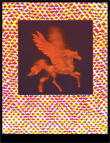Please, don't confuse Hologravure (new 3D DESIGN technology) with other 3D technologies (lenticular images, holography, anaglyphs, etc.) …
The 3D effects are quite different … the applications, too.
3D DESIGN TECHNOLOGY IN CONVENTIONAL PRINTING WITH OR WITHOUT DYNAMIC EFFECTS, AND SPECIFIC Hologravure EFFECTS ( iridescence, changing of colors, light effects, virtual transparency, security codes, etc. )
New process of technological design (optic printing) giving many special new effects of design (3D, dynamic effects, iridescence, changing of colors, etc.)
3D DESIGN using Hologravure technology
- with nice dynamic effects when you move the picture or when you walk in front of the picture ( possibility of 3D design ) …
- no limit for the 3D design in traditional printing (hundreds of samples in these blogs)
- + special effects Hologravure (iridescence, high resolution, etc.)
- images completely stable in space, regardless of the angle of observation (no image jumping, unless required)
- thickness : Hologravure (very thin medias)
LENTICULAR
3D TECHNOLOGY IN CONVENTIONAL PRINTING WITH OR WITHOUT ANIMATED PICTURE (flip, zoom, morphing, etc.)
The picture is in 3D, with flip, zoom, morphing, etc. but no possibility of design with this technology.
3D, dynamic effects using flip, zoom, morphing ( less possibility of design )
- less possibility of design
- + flip, zoom, morphing
- jumping image
- thickness : lenticular (thicker medias than Hologravure)
The picture is in 3D, but no possibility of design with this technology.
 |
| Holography with Hologravure background |
ANAGLYFS
Anaglyphs: 1853 until today
Stereoscopic process developed by Louis DUCOS DU HAURON in 1891.
THERMOFORMING








